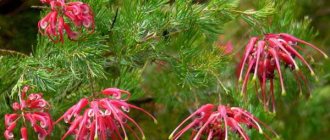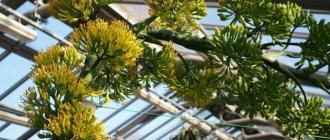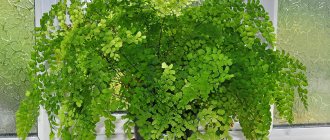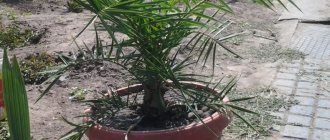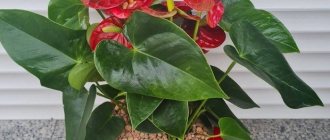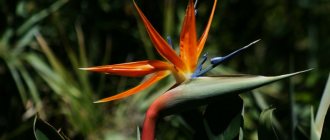Author: Elena N. https://floristics.info/ru/index.php?option=com_contact&view=contact&id=19 Category: Houseplants Published: February 09, 2019Last edits: January 11, 2021
- Growing from seeds
- Royal Strelitzia (Strelitzia reginae)
Strelitzia is an unusual flower with amazing, unique beauty. Strelitzia flowers can remain fresh when cut for about a month, and remaining on the plant they wither faster than in a vase. You should know that Strelitzia juice is poisonous, so you should keep the plant away from children and animals.
Strelitzia flowers resemble the shape of a bird with variegated plumage, and if you want to grow this treasure on your windowsill, read our article. From it you can learn:
- what types of strelitzia exist;
- how to care for a flower at home;
- how to make a plant bloom;
- how to propagate strelitzia.
Planting and caring for Strelitzia
- Flowering: in spring for one and a half months.
- Lighting: bright diffused light (western or eastern window sills).
- Temperature: during the growing season - normal for residential premises, but in winter - no higher than 14 ˚C.
- Watering: during the period of active growth - moderate but frequent: the soil should be slightly moist all the time; in winter - no more than once every 10 days.
- Humidity: high. The plant requires spraying the leaves in hot weather.
- Fertilizing: during the period of active growth and flowering, alternately with organic and mineral fertilizers three times a month.
- Rest period: conditional, in winter.
- Transplantation: young Strelitzia are replanted annually, adults - once every 3-4 years.
- Reproduction: freshly collected seeds, side shoots and parts of those plants that are 6-7 years old.
- Pests: scale insects, mealybugs, aphids and spider mites.
- Diseases: in general, the plant is resistant, but root rot can develop from excessive moisture of the substrate.
Read more about growing Strelitzia below.
plant (lat. Strelitzia) , or strelitzia , is a type genus of the Strelitzia family, consisting of only four species, whose range is located in South Africa and Madagascar. The Strelitzia flower was named in honor of Charlotte Sophia of Mecklenburg-Strelitz, Queen of Great Britain, wife of King George III. By the way, one of the types of strelitzia was called “royal”, and another type was called Strelitzia Nicholas in honor of the autocrat of the All-Russian Nicholas I. This is the royal pedigree of Strelitzia. In common parlance, Strelitzia is called the “bird of paradise,” and this name most fully reflects the extraordinary beauty of the flower.
Rules of care
Strelitzia is not a demanding crop, but, like other exotics, it needs careful handling.
Lighting
The lighting should be bright, but slightly diffused. Direct rays can leave burns on the leaves and the plant will lose its decorativeness and attractiveness. Small pots are best placed on eastern and western windowsills. Larger (floor) specimens can be placed near southern, western and eastern windows.
Temperature
The tropical plant loves warmth, but can easily tolerate short-term changes. The optimal temperature in Vienna and in summer is +20 +25 °C. In the autumn-winter period, not less than +12 +14 °C.
Watering mode
In spring and summer, the plant is watered moderately but often. The soil should always be slightly moist. The earthen clod should not be allowed to dry out completely, nor should moisture stagnate at the roots. In winter, the amount of watering is reduced to once every 10–14 days.
Air humidity
A tropical guest needs high humidity. Therefore, flower growers recommend wiping the leaves with a damp sponge or spraying them.
Fertilizer and feeding
You can fertilize the plant during the growing season and flowering period. The fertilizing interval is 20–25 days. Strelitzia responds favorably to complex mineral supplements and organic fertilizers.
Botanical description
Strelitzia flowers in nature are evergreen herbaceous perennials, the largest of which reach a height of more than ten meters, and the rest - from two to three and a half meters. The root system of Strelitzia is taprooted, going deep into the ground. Strelitzia leaves are large, oval-shaped, leathery, green with a bluish-blue bloom, from 30 to 200 cm long, from 10 to 80 cm wide, strongly reminiscent of banana leaves, only with longer petioles - from 50 to 90 cm. Flowers on a long peduncle with orange and purple petals in a horizontal inflorescence, similar to the crest of a strange bird, reaching a diameter of 10 to 20 cm. From 5 to 7 flowers open on one peduncle, and there can be six or more peduncles on one plant, which is why Strelitzia blooms can last up to six months. With proper care, indoor Strelitzia can bloom not only for a long time and profusely, but also several times a year. Strelitzia flowers last a long time when cut - from two to four weeks.
- Pereskia: home care
When and how does it bloom?
Period
If a flower is to bloom for the first time, then this process begins in the spring or summer of the 4-5th year of life. This flower can rightfully be called one of the most unusual because of its flowers and rather large stems. Its color is also fascinating: the outer leaves are orange, and the inner leaves are dark blue.
In appearance, the flower looks like a bird in flight, which is why it is popularly called the “bird of paradise.” The flowers are odorless, but they have a lot of nectar . There is so much of it that droplets of nectar flow beyond the edges of the flower's flower.
Before flowering, a process of so-called dormancy occurs, at which time flower buds are laid. This is considered the preparatory period. The flowers themselves reach a size of 10-20 cm. It is considered normal when there are 5 – 7 flowers on one peduncle. But on one plant the number of pedicels can be more than six, so it blooms almost until the dormant period.
Why isn't this happening?
There are several reasons:
- Perhaps this is due to the small amount of feeding, she likes to be fed every 10 days during the preparation for flowering and growing season.
- Another reason could be an unsuitable pot, check.
What to do?
If Strelitzia does not bloom for a long time, then in this case you can try treatment by changing the temperature regime. To do this, the flower must be placed for some time in conditions where the temperature is only 10-12°C, and then returned to its original place. As a rule, this helps stimulate the flowering process.
Don’t forget to cut the flowers correctly, then they will surprise you with their vitality. If the flowers are placed in ordinary water, they will live for about 14 days . But if they are placed in a special maintenance solution, their life expectancy will increase to 30 days. Only orchids have a longer flowering time.
This useful video explains what to do to make Strelitzia bloom:
Thus, we can conclude that if you are the owner of Strelitzia, then you are definitely lucky. This flower is of extraordinary beauty. We can say with one hundred percent certainty that it will delight you and your loved ones.
Strelitzia care at home
Growing conditions
Strelitzia at home is not at all capricious, despite its exoticism. It is best to place it on the east or west side under bright diffused light, but at the same time protecting it from direct sunlight. Strelitzia is thermophilic, but likes to spend the winter in a cool room, where the temperature does not rise above 14 ºC. The rest of the time she will be comfortable at the temperature that suits you.
The houseplant Strelitzia loves fresh air, and if you have the opportunity to take it out to the balcony or garden in the summer, be sure to use it, but remember that Strelitzia needs to be shaded from the bright sun and protected from the wind.
Water Strelitzia in the warm season so that the soil is slightly moist all the time - often, but not too much, avoiding stagnation of moisture in the roots. In winter, it is enough to moisten the soil once a decade. Water for irrigation is settled or filtered and, if necessary, heated to room temperature or a couple of degrees warmer. Homemade strelitzia prefers slightly increased air humidity, so in hot weather its leaves should be sprayed or wiped with a damp sponge.
Caring for Strelitzia involves alternately applying organic and mineral fertilizers three times a month during the period of active growth and flowering. When Strelitzia fades, stop feeding for 2-3 months while the dormant period lasts. Before placing the plant to rest in cool conditions, it is better to cut off the flower stalks.
Transfer
Annual spring replanting of young plants accelerates their development. Adult plants are not transplanted so often - after 3-4 years, since the fragile roots of Strelitzia are often injured during transplantation. How to plant Strelitzia to relieve the root system from stress?
First, let's prepare the soil for Strelitzia: loose, fertile soil is made up of leaf, humus and turf soil, peat and sand in equal proportions. A pot for Strelitzia is chosen high and deep, a thick layer of drainage material is placed on the bottom, then a layer of soil, and after that the plant is carefully transferred, if it is healthy, into a new container. All that remains is to gradually add soil to the pot and compact it until there is enough soil.
- How to trim currants - differences and features of pruning black, red and white
If the plant has problems with the root system, then planting Strelitzia in a new pot is preceded by removing all unhealthy and suspicious areas from the roots and treating the wounds with crushed charcoal.
Pests and diseases
Sometimes Strelitzia is affected by spider mites, mealybugs or scale insects. Scale insects and scale insects are destroyed by double treating the plant with actara with an interval of three weeks between sessions. Ticks are eliminated with acaricides. Strelitzia is very disease-resistant, and if you care for it properly, it will always be healthy and beautiful.
Why doesn't Strelitzia bloom?
The plant begins to bloom when it reaches four to five years of age, but what if Strelitzia does not bloom, although it has already matured enough to do so? Give it temperature stress: take the plant out in winter or early spring for a while to an insulated balcony, loggia or unheated veranda when the temperature there is between 10-12 ºC. After this, move it to its usual conditions, place it in a well-lit place, resume normal care and wait for flowering.
Diseases and pests
Strelitzia is an exotic, heat-loving plant. But despite its tropical roots, the flower has strong immunity and rarely gets sick.
With proper care, growing exotics will not cause problems, but violating the rules will lead to quite unpleasant consequences.
| Diseases and pests | Cause, symptoms and signs of the disease | Treatment and prevention |
| Violation of planting and care standards | Massive wilting, yellowing of leaf blades. Reasons: root rotting due to excessive watering and stagnation of moisture. | Adjustment of care and elimination of causes. |
| Yellowing of leaves. Causes: low temperature, lack of microelements, sunburn or lack of light. | ||
| The edges of the leaves dry out. Reason: dry indoor air, high temperature or insufficient watering. | ||
| Slow growth during the growing season. Reason: cramped pot, lack of microelements. | ||
| Shchitovka | Brown-gray growths appear on the inside and outside of the leaf blades, as well as on the stems of the plant, which cannot be removed with a fingernail. The surface of leaves and stems becomes sticky from traces of insect activity. | Pests are removed using a toothbrush or a pointed stick. The plant is treated with systemic insecticides twice with an interval of 10–15 days. |
| Spider mite | Pinholes (dark dots) are visible on the surface of the leaves. The plates curl, turn yellow and dry out. With severe damage, the plant becomes covered with a thin cobweb. | At the initial stage, double treatment with soap solutions helps. In severe cases, double treatment with broad-spectrum acaricides is required. |
| Aphid | The leaves wither and dry out. On the inside you can see small, transparent white insects. The leaves and stems of the plant become covered with a sticky coating. | For mild damage, soaping the leaf blades and stems helps. If there are a lot of insects, it is necessary to treat the plant with insecticidal preparations twice with an interval of 10–15 days. |
| Mealybug | White fluffy lumps form at the base of the leaves. | Reduce watering, remove damaged leaves. Insecticide and fungicide treatment |
Strelitzia propagation
Growing from seeds
Strelitzia seeds lose their viability very quickly. It is best to propagate the plant with freshly collected seeds, but at home they can only be obtained by artificial pollination of the plant, therefore, when buying Strelitzia seeds in a store, carefully look at the labeling, since only every tenth of the seeds that are six months old is viable. After purchasing, sow the seeds without delay and regardless of the time of year, but first soak them in warm water (35-40 ºC) for a day, constantly changing the cooled water to warm. Then remove any remaining fruit pulp from the swollen seeds, if any.
While the seeds are swelling, prepare a soil mixture of peat, compost and river sand in equal proportions, fill 2/3 plastic cups with a capacity of 250 ml with it, making several holes with a diameter of 5 mm in the bottoms of the cups. Pour boiling water over the soil, compact it, let it cool, pour a two-centimeter layer of sand on top, then put a seed in each glass and press it into the sand so that the “backs” of the grains remain visible. Now place the cups with the crops in a bright, warm (22-24 ºC) place where there is no direct sunlight, cover with glass and forget about them until you see the first leaf.
This will not happen soon - you will have to wait from one and a half to six months - but try to overcome the temptation to remove the glass before the shoots appear. And even then, when some seedlings give the first leaf, you can remove the glass from them only for 15-20 minutes a day, but the rest of the cups should remain under the glass. Sprouted seeds require moistening the soil with boiled water, which is carried out only after the top layer has dried. Grown seedlings are carefully transplanted into larger pots. Remember that the roots of Strelitzia are taprooted, long, thick and fragile, and injury to them can lead to growth retardation or even death of the plant. Young Strelitzia are grown at a temperature of 22 ºC, good lighting and moderate watering.
Vegetative methods of propagation
For this type of propagation, side shoots of Strelitzia or parts of a plant that is already 6-7 years old are used. It is best to divide Strelitzia after it has finished blooming. The plant is removed from the pot and divided so that each division has at least one shoot. Delenki or side shoots, depending on their size, are planted in pots with a diameter of 16 to 20 cm, the composition of the earth mixture is the same as for Strelitzia seedlings. We remind you once again: try not to damage the roots of the plant.
- Saintpaulia: planting cuttings in soil with hydrogel
Flower transplant
Soil preparation
Young plants need to be transplanted into different containers every year, as the roots grow deeper and need more space. This is also done to speed up the development process. When the “flower of paradise” grows to 3 years old, such frequent replanting is stopped.
Grown individuals are replanted every four years . Because the root system is very fragile and can break easily and the plant can therefore become sick. At best, you will have to wait a long time for flowering, but the consequences may be much worse.
If the plant has damaged areas, they should be sprinkled with activated carbon, ground to a powder consistency.
The plant is perfectly suited to slightly acidic soil, closer to neutral. Before replanting, it is better to mix the nutritional components into the soil in advance. It should include river sand, peat and humus, always in equal parts.
Choosing a pot
For Strelitzia, tall, tapered pots are best suited. At the bottom you need to put a layer of expanded clay for drainage (approximately 5 cm), then nutritious soil, and then carefully plant the plant. If the flower has problems with roots, then in this case the dead roots are first cut off and only then replanted.
You need to choose a pot depending on the growth of the plant . If you want to transplant a very small plant, then the size of the product required is not so large. But if the individual is already an adult, then a large floor pot will be required to make the plant comfortable in it.
Kinds
Royal Strelitzia (Strelitzia reginae)
The most commonly grown plant is Strelitzia regal, which is also called Strelitzia parvifolia. This species lives in the Cape Province of South Africa, in mountain forests and reaches a height of two meters. Large, up to 45 cm long, slightly wavy at the edges, the leathery leaves of Strelitzia regal, dark green in color, on petioles up to 90 cm high, are collected in dense rosettes. The peduncle is tall, axillary, with a green spathe with red veins. The flower's outer petals are orange, up to 15 cm long, and the inner petals are dark blue. Strelitzia reginae blooms twice a year.
Strelitzia nicolai
It also grows in tropical forests, gorges, and mountains at an altitude of about 300 m above sea level in the Cape Province. The plant resembles a banana in appearance, which is why it is sometimes called the “wild banana of Natal”. Strelitzia Nicholas grows up to 10 meters in height, therefore it is a tree species. Its “trunks” look like palm trees because of the scars from fallen leaves. The flowers are as monumental as the plant itself: on an axillary peduncle, with four beak-shaped red-green spathes, with white outer and blue inner petals up to 17 cm long.
Mountain Strelitzia (Strelitzia caudata)
It grows in the very south of Africa. This is a rare species, locally called the “desert banana.” Strelitzia montana is a tree-like plant, reaching ten meters in height, with giant leaves growing in two rows and clasping the bottom of the trunk. The flowers are also large, white, with pointed red bracts in the shape of boats up to 45 cm in length.
Strelitzia juncea
It grows in the east of South Africa and tolerates long-term drought and sudden temperature changes, down to sub-zero. In flowers it is very similar to Strelitzia regal, but its leaves are narrow, needle-shaped, growing in a dense rosette with a diameter of two meters.
Strelitzia Augusta, or white strelitzia (Strelitzia alba)
Also from South Africa, from the Cape Province. This is a perennial plant with a woody lower part. Its long, elliptical, glossy, light green leaves reach a length of one meter and are heart-shaped at the base. Peduncles are axillary, with two lanceolate bracts, with a single purple spathe. The flower petals are white.
There is also a hybrid of Strelitzia regal and Strelitzia alba.
Interior use
Strelitzia can decorate any room with its exotic appearance. Large glossy leaves and original buds can surprise even the most indifferent guests or visitors.
Tall “birds of paradise” fit perfectly into modern interiors and can complement even the most daring design.
Pots with unusual plants are often placed in recreation rooms on verandas and loggias. They fill up extra space and attract the eye. With the help of Strelitzia, you can decorate a green area right in your apartment, complementing the design with low-growing bushes and decorative foliage plants.
Small flowerpots are placed on stands, and large specimens look great on the floor. The plant does not take up much horizontal space, so finding a place for a pot is quite easy even in small spaces.
Features of the plant
South Africa is the birthplace of an exotic beauty. There is especially a lot of it on the coast of South Africa. Here Strelitzia grows along the banks of drying streams and on fertile loose sandstones in the humid subtropics.
Strelitzia (the name strelitzia is often used) are perennials with dark green concave leaves of a wide elliptical shape. The height of bushes in the natural environment can range from one and a half to ten meters.
The flowers are similar to the heads of unusual birds. Each of them has a picturesque crest. No wonder the second name of Strelitzia is bird of paradise. The originality of the flower is undeniable, surpassing even the amazing “lipstick” plant aeschynanthus or the fiery gloriosa flower.
The heads of the “birds of paradise” open on long peduncles. The bud looks like a narrow gray capsule located at an angle to the peduncle. When ready to bloom, it forms a narrow gap at the top through which large, bright sepals and petals pop out. Looks very similar to a peacock's crest.
The sepals of most plant species are yellow-orange, the petals are blue or with a purple tint. The photo of Strelitzia shows how tightly the blue petals are closed. There the flower covers the stamens with pollen and nectar.
Upon completion of flowering, a fruit is formed in the form of a capsule with seeds. Strelitzia also has unusual seeds - black peas with a fuzzy orange tuft.
The decorative qualities of the plant served as an effective reason to use it in gardening and landscape design. Strelitzia then moved into indoor culture.
Annual flowering occurs after the plant is 4-5 years old. Adult specimens (over 8 years old) love to live in voluminous tubs and require space to match their size.
Strelitzia tolerates varying soil acidity and salinity well. Genetically, the plant hardened, spreading in coastal areas in open space and getting used to sea winds and unstable weather. Cyperus loves this kind of habitat.
Growing from seeds
Strelitzia can be grown using seeds. At the same time, this path is quite complex and time-consuming.
Artificial pollination
Artificial pollination is used to grow plants from seeds. Take a cotton swab or brush, carefully remove pollen from one flower and carefully transfer it to another. After a few months, dense boxes appear in place of the flowers, inside which there are round, black or dark brown seeds.
Before planting, they are soaked for a day in warm water, changing it periodically.
Soil mixture
Light soil consisting of:
- sand;
- peat;
- compost.
Or a universal substrate for indoor plants, which can be purchased at a flower shop.
Selecting a location
The seeds are planted without going too deep into plastic cups, at the bottom of which drainage holes of 5–7 mm are made in advance.
Deadlines
After planting, the containers are covered with film. With regular ventilation and moisture, the seeds germinate after 1–6 months.
Hydration
After the sprouts appear, the soil is moistened as the top layer dries. Overflow is not allowed. It is best to use a spray bottle.
Temperature, lighting, watering
Keep pots at a temperature of 20–22 degrees. They protect from direct rays of the sun, but do not hide in the shade. For irrigation, use settled water at room temperature.
Watering is carried out as soon as the top layer of the substrate dries.
We invite you to watch a video about growing Strelitzia reginas from seeds:
Temperature conditions
The best temperature for the plant will be 20-25 degrees. In winter, you need to reduce the temperature to fifteen degrees. This is necessary to create a preparation period during which the plant prepares for the flowering period.
Soil and fertilizing
The best soil should contain peat, leaf and turf soil. You can purchase special soil or use regular soil for indoor plants.
Fertilizing is simply necessary: it will allow the plant to grow well, be strong enough and eliminate the need for a dormant period.
Strelitzia juncea
This type of Strelitzia is very different in description from the larger varieties. And the point is not only in its more modest size, but also in the appearance of the plant. A desert species from the east of South Africa, it is perfectly adapted to long dry periods and, unlike other Strelitzia, tolerates temperature drops to light frosts.
The orange-purple flowers of the reed strelitzia closely resemble those of the royal variety. However, the appearance of the foliage will not allow these plants to be confused. A dense rosette is formed by elongated leaves-needles covered with a waxy coating, completely devoid of leaf blades and growing to a length of 1.5–2 meters.
Due to the great demand among flower growers from all over the world, in nature the species of Strelitzia, whose description is given above, is in danger of extinction. To propagate flowers, nurseries use bioculture, vegetative methods, and artificial pollination to produce seeds.
Popular questions and answers
We asked houseplant collector Elizaveta Starostina - she answered the most popular questions from gardeners.
How to choose Strelitzia?
In indoor conditions, it is realistic to grow only 2 types of Strelitzia - regal Strelitzia and reed Strelitzia. Choose plants that look healthy. Ideally, it is better to buy a flowering plant so as not to wait a couple of years for flowering. Small seedlings grown from seeds sometimes stop developing and die over time. And remember: Strelitzia is a large plant, it needs a lot of space in your home.
What kind of pot is needed for Strelitzia?
For my strelitzia, I choose a tall pot so that it looks harmonious on the floor. I fill it almost a third with expanded clay and only then fill it with soil and plant the plant. A large amount of expanded clay improves the quality of watering and facilitates the process of transplanting plants into new pots - the earthen ball can be easily removed from the old pot.
Why do Strelitzia leaves dry out?
There can be at least two reasons - too dry indoor air and spider mite infestation.
Why do Strelitzia leaves turn yellow?
Yellowing of the leaves may be due to dry air or waterlogging of the earthen ball. Less commonly, yellowing is caused by a lack of nitrogen or iron in the soil.
How to make Strelitzia bloom?
Strelitzia begins to bloom at the age of 4 years. However, even an adult plant does not always please with flowering. This can be caused by several reasons: - too high doses of nitrogen when fertilizing; — the root system is damaged during transplantation; — there is not enough lighting.
To stimulate flowering in spring, use Ovary preparations. Or give the Strelitzia temperature stress: for 5–6 days, take the pot out to the balcony, where the temperature is 10–12 °C, then return it to normal room conditions.


